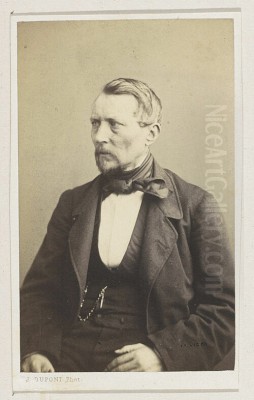
Jan Michiel Ruyten, a distinguished Belgian painter of the 19th century, carved a notable niche for himself through his evocative cityscapes, lively genre scenes, and atmospheric marine paintings. Born in Antwerp in 1813 and passing away in the same city in 1881, Ruyten's artistic journey was deeply intertwined with his native city, which served as a constant muse. His works offer a valuable window into the urban and social fabric of his time, rendered with a characteristic attention to detail and a keen understanding of light and atmosphere. While perhaps not as globally renowned as some of his contemporaries, Ruyten's contribution to Belgian art, particularly in the depiction of Antwerp, remains significant.
Early Life and Artistic Formation in Antwerp
Jan Michiel Ruyten, whose name is sometimes Gallicized to Jean Michael Ruyten, entered the world on April 9, 1813, in Antwerp. This bustling port city, with its rich artistic heritage stretching back to masters like Peter Paul Rubens and Anthony van Dyck, provided a fertile ground for young artistic talents. Ruyten's formal artistic education began under the tutelage of Ignatius Josephus van Regemorter (1785-1873), a respected painter and teacher in Antwerp known for his genre scenes and landscapes. Van Regemorter, himself a student of Balthasar Paul Ommeganck, would have instilled in Ruyten a foundation in the prevailing academic traditions.
To further hone his skills, Ruyten sought instruction in the Netherlands, studying with the gifted Romantic landscape painter Wijnand Nuyen (1813-1839). Nuyen, despite his tragically short life, was a significant figure in Dutch Romanticism, celebrated for his dramatic landscapes, coastal scenes, and innovative use of color. This period of study with Nuyen likely exposed Ruyten to the dynamism and emotional depth characteristic of the Romantic movement, influencing his approach to landscape and marine subjects. The interplay between the structured academicism of Antwerp and the expressive freedom of Dutch Romanticism would shape Ruyten's unique artistic voice.
The Artistic Milieu of 19th-Century Belgium
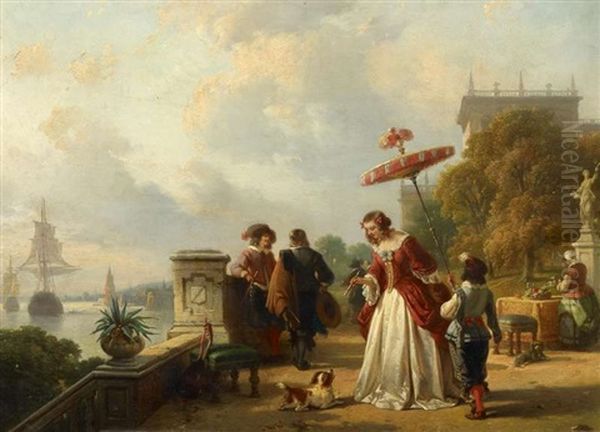
Ruyten's career unfolded during a vibrant period in Belgian art. Following Belgium's independence in 1830, there was a surge in national pride, which often translated into a renewed interest in historical subjects and local landscapes. Romanticism was a dominant force in the early to mid-19th century, with painters like Gustave Wappers (1803-1874), Nicaise de Keyser (1813-1887), and Hendrik Leys (1815-1869) achieving great acclaim for their grand historical canvases. Leys, in particular, also an Antwerp native, developed a distinctive style that revived the aesthetics of 16th-century Flemish masters, influencing a generation of artists.
While Ruyten did not typically engage with the large-scale historical narratives favored by some of these leading figures, his work shared the Romantic era's appreciation for local color, atmospheric effects, and detailed observation. His focus on cityscapes, genre scenes, and marine paintings aligned with a broader European trend where artists increasingly turned to contemporary life and the observable world for inspiration. He was a contemporary of other notable Belgian artists such as Jean-Baptiste Madou (1796-1877), known for his charming genre scenes, and later, figures like Henri de Braekeleer (1840-1888), who brought a more intimate and introspective approach to genre painting in Antwerp. The Dutch artistic scene, with figures like Andreas Schelfhout (1787-1870) and Barend Cornelis Koekkoek (1803-1862) excelling in Romantic landscapes, also remained an influential backdrop.
Antwerp: A Perennial Muse
Antwerp, with its historic architecture, bustling port, and vibrant street life, was undoubtedly Ruyten's most significant source of inspiration. He meticulously captured the city's landmarks and everyday scenes, demonstrating a profound affection for his hometown. His paintings often depict well-known locations, providing a visual record of Antwerp in the 19th century.
Works such as Vistas op de Grote Markt met de Vrijheidsbank (View of the Grote Markt with the Liberty Tree/Bridge) and Zicht op de Grote Markt van Antwerpen (View of the Grote Markt of Antwerp) showcase his ability to render complex architectural settings populated with numerous figures. These paintings are not mere topographical records; they are imbued with the life of the city, capturing the interactions of its inhabitants and the prevailing atmosphere. The Grote Markt, Antwerp's central square, with its ornate guildhalls and the Brabo Fountain (though the current fountain dates from after Ruyten's death, earlier versions or the space itself would have been a focal point), offered a rich tapestry of urban life that Ruyten skillfully translated onto canvas.
His depictions often include a multitude of figures, each engaged in some activity, contributing to the overall sense of a living, breathing city. This attention to human detail within the urban landscape is a hallmark of his cityscapes, distinguishing them from purely architectural studies.
Marine Paintings and the Scheldt
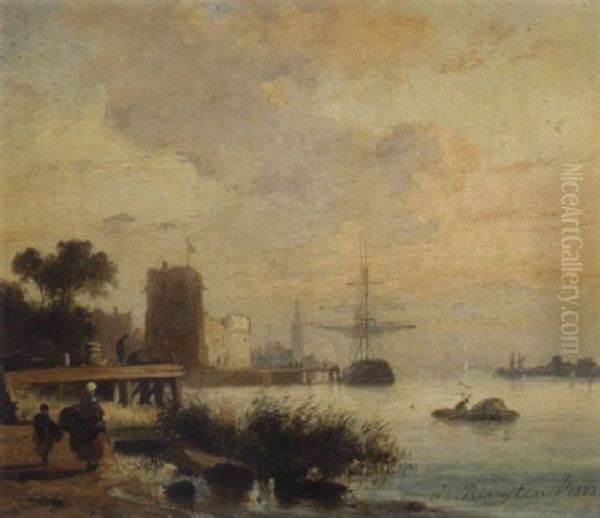
Given Antwerp's status as a major port on the Scheldt River, it is natural that marine themes also featured prominently in Ruyten's oeuvre. He painted numerous scenes of the river, the harbor, and the diverse array of vessels that frequented its waters. Works like Schelde met herbergboot (Scheldt with an inn boat/ferry) and Havenie met vissersbooten op de strand (Harbour scene with fishing boats on the beach) illustrate his engagement with maritime life.
These paintings often capture the atmospheric conditions of the river and coast – the play of light on water, the movement of clouds, and the tangible sense of a working waterfront. His marine works, like his cityscapes, are characterized by careful observation and a desire to convey the specific character of the location. The depiction of different types of boats, from humble fishing vessels to larger ships, demonstrates his keen eye for nautical detail. The Scheldt was not just a backdrop but an active participant in the life of Antwerp, and Ruyten's paintings reflect this symbiotic relationship. Other works like Antwerpen op de Schelde (Antwerp on the Scheldt) further emphasize this connection.
Genre Scenes and Everyday Life
Beyond grand city views and expansive marine vistas, Ruyten also excelled in capturing more intimate genre scenes, often set within his beloved Antwerp or its environs. Paintings like Entertainment on the Ice (1842) and Entertainment before Inn (1842) reveal his interest in the social customs and leisure activities of his contemporaries. These works are filled with anecdotal detail, offering charming glimpses into 19th-century life.
Gesellschaft op de Schlossterreife (Company on the Castle Terrace) or the similarly titled Gesellschaft auf der Schlossterrasse mit der Schelde bei Antwerpen (Company on the Castle Terrace with the Scheldt near Antwerp, 1856) likely depict groups of people enjoying themselves in picturesque settings, combining elements of landscape and genre. The painting EN SE RÉCHAUFFANT (Warming Themselves), which appeared at auction, suggests a scene focused on a simple, relatable human activity, perhaps during a cold day. These genre paintings highlight Ruyten's versatility and his ability to find artistic inspiration in the ordinary as well as the monumental.
Stylistic Characteristics and Key Works
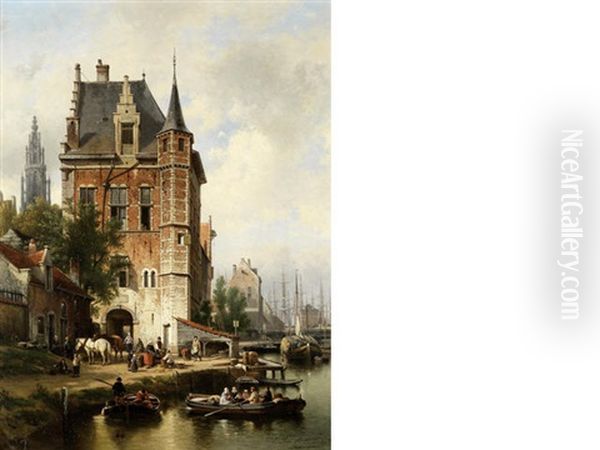
Jan Michiel Ruyten's style is generally characterized by its precision, clarity, and detailed rendering. He employed fine brushwork, allowing for a high degree of finish and a realistic depiction of textures, fabrics, and architectural elements. His use of light is often subtle but effective, creating a sense of depth and atmosphere. While influenced by Romanticism, particularly in his landscapes and marine scenes which could evoke mood and the power of nature, his cityscapes often lean towards a more objective, detailed realism, albeit one that is never cold or sterile, always animated by human presence.
One of his notable works, The Iconoclasts (De Beeldenstormers), housed in the Groeningemuseum in Bruges, represents a foray into historical genre. This subject, referring to the wave of destruction of religious images that swept through the Low Countries in the 16th century, was a popular theme in 19th-century Belgian art, often tied to narratives of national and religious identity. Ruyten's treatment of this theme would have allowed him to combine his skill in figure painting with a dramatic historical narrative.
Other significant works that showcase his typical subjects and style include:
Exodus (1838): The title suggests a narrative or historical scene, possibly biblical or allegorical, which would be an interesting comparison to his more common city and landscapes.
River Bank (1840/1848): A classic landscape subject, allowing for the depiction of nature, water, and potentially figures interacting with the environment.
A Sail (1842): Likely a marine painting focusing on a sailing vessel, showcasing his skill in depicting ships and water.
View of Antwerp (1842): A general title that could encompass various perspectives of his favorite city.
Fisherman's Boat Stranded (1842): A marine scene with a narrative element, perhaps highlighting the perils or daily realities of fishing life.
Harbour of Winter (or Winter Harbour) (1842) and Winter of Antwerp (1842): These titles indicate his interest in seasonal depictions, particularly winter scenes which were popular in Dutch and Flemish art, offering opportunities to explore specific light effects on snow and ice, and activities like skating as seen in Entertainment on the Ice.
City on a River, Canal in Antwerp, St. Paul's Church (1842): This title points to a detailed cityscape, possibly focusing on a specific district of Antwerp and its notable landmarks like St. Paul's Church, known for its Baroque architecture and rich art collection.
These works, painted relatively early in his mature career (around 1842), demonstrate the range of subjects he was tackling and the consistent quality of his output. His dedication to capturing the specifics of place and time makes his oeuvre a valuable historical and artistic resource.
Ruyten's Contemporaries and Artistic Context
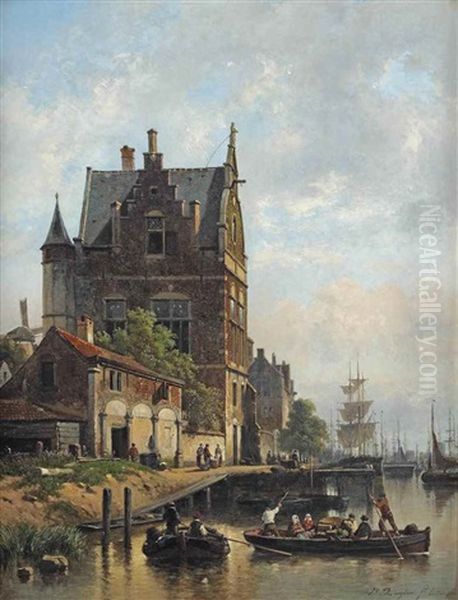
To fully appreciate Ruyten's work, it's helpful to consider him within the broader context of 19th-century European art. In Belgium, artists like Florent Willems (1823-1905) and Alfred Stevens (1823-1906) gained international fame for their elegant genre scenes, often depicting wealthy bourgeois life with exquisite attention to fabrics and interiors. While Ruyten's genre scenes were perhaps more focused on everyday urban life, they shared a commitment to detailed realism.
In the Netherlands, the legacy of the 17th-century Golden Age masters continued to resonate. Landscape painters like Andreas Schelfhout and B.C. Koekkoek were highly successful with their Romantic interpretations of the Dutch countryside. Later in Ruyten's career, the Hague School, with artists such as Jozef Israëls (1824-1911), Anton Mauve (1838-1888), and the Maris brothers (Jacob, Matthijs, and Willem), emerged, championing a more atmospheric and tonal approach to realism, often depicting rural life and landscapes with a sense of sober poetry. While Ruyten's style remained more detailed and less "impressionistic" than the Hague School, his focus on local scenery and everyday life aligns with the broader realist tendencies of the period.
Internationally, the French Barbizon School, with painters like Jean-Baptiste-Camille Corot (1796-1875) and Jean-François Millet (1814-1875), was revolutionizing landscape painting by emphasizing direct observation from nature and a more naturalistic portrayal of light and atmosphere. While Ruyten's connection to such movements is not explicitly documented, the general artistic currents of the time would have undoubtedly been part of the discourse in artistic circles in Antwerp and beyond.
The Market and Legacy of Jan Michiel Ruyten
Jan Michiel Ruyten's paintings were appreciated during his lifetime and continue to find a place in collections and at auction. The sale of his work EN SE RÉCHAUFFANT for a sum between 800 and 1200 Euros, as noted in auction records, indicates a continued, if modest, market interest. His works are held in public collections, most notably The Iconoclasts in the Groeningemuseum, Bruges, which ensures his representation within Belgium's national artistic heritage.
While the provided information does not detail extensive interactions with specific artistic groups or extensive personal correspondence, his role as a student of Van Regemorter and Nuyen places him within established networks of artistic training and influence. His contemporary, Herman Henry op de Heyden (1813-1857), shared a similar lifespan, though direct collaborations or close associations are not specified in the available material. The absence of detailed records about his involvement in specific art movements or societies does not diminish the quality of his work but rather suggests he may have been an artist who focused diligently on his craft, contributing through the consistent production of high-quality paintings centered on his chosen themes.
His legacy lies primarily in his affectionate and detailed portrayal of Antwerp. For art historians and social historians alike, Ruyten's paintings serve as valuable visual documents, capturing the appearance and atmosphere of the city in the mid-19th century. He was a skilled practitioner of a tradition of urban view painting that has deep roots in Flemish art, adapting it to the sensibilities of his own time.
Conclusion: A Dedicated Chronicler
Jan Michiel Ruyten stands as a significant Belgian artist of the 19th century, a dedicated chronicler of his native Antwerp and the life that unfolded within its streets, along its river, and in its surrounding landscapes. His education under both Belgian and Dutch masters provided him with a solid technical foundation and an appreciation for both academic precision and Romantic expressiveness.
His prolific output, encompassing detailed cityscapes like View of the Grote Markt van Antwerpen, atmospheric marine paintings such as Schelde met herbergboot, and engaging genre scenes like Entertainment on the Ice, demonstrates his versatility and his keen observational skills. Works like The Iconoclasts also show his capability in handling historical subjects.
While he may not have been an avant-garde revolutionary, Ruyten excelled within the established genres of his time, creating works of lasting charm and historical interest. His paintings offer a window into a bygone era, rendered with a meticulousness that invites close inspection and an affection for his subjects that resonates with viewers even today. Jan Michiel Ruyten's contribution to the rich tapestry of Belgian art is secured by his skillful and heartfelt depictions of the world around him, particularly the enduring allure of Antwerp. His art remains a testament to a painter deeply connected to his time and place.